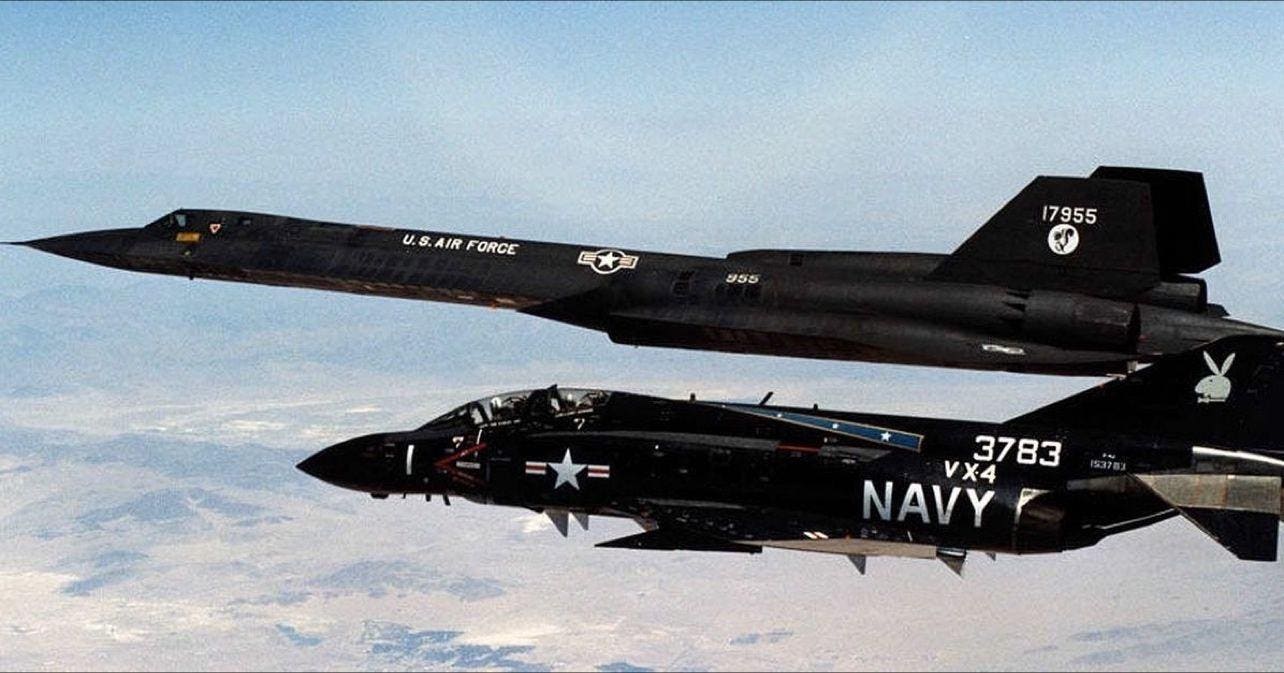The Navy and Air Force recently recreated a renowned photo from the 1970s to make a point about the national asset that is the R-2508 test range in southern California.
The photo, which shows a Navy F-4J Phantom from the then Point Mugu-based Air Test and Evaluation Squadron Four (VX-4) in formation with one of the Air Force’s legendary Mach 3-plus SR-71 Blackbirds from Beale Air Force Base, was originally staged to place these two black birds together over the R-2508 test range.
Referred to as the “R-2508 Complex” the range stretches over 20,000 square miles of Special Use Airspace encompassing portions of Fresno, Inyo, Kern, Los Angeles, San Bernardino, and Tulare counties. Most of the Complex lies overhead of other federally owned lands including national parks, national forests, and Bureau of Land Management (BLM) property.
The airspace is a vital national asset, crucial to the testing and development of advanced aircraft, spacecraft and other technologies central to national security. It is the largest single area of overland Special Use Airspace in America, established during the height of the Cold War in 1955 as a controlled space to operate experimental and other military aircraft in test and operational evaluations.
The majority of America’s world famous “X-planes” flew and were developed here. They still ply its skies today. The area is managed and utilized by Naval Air Weapons Station China Lake, the Army’s National Training Center at Fort Irwin, and the Air Force Test Center, at Edwards Air Force Base, all in California.
Recently, Air Test and Evaluation Squadron 9 (VX-9), a successor to VX-4, arranged a photo flight to commemorate the formation seen above. In doing so, it is calling attention to southern California’s military aerospace testing legacy, to almost 70 years of multi-service cooperation in test and evaluation, and to the value of R-2508 which is threatened by encroachment.
High above the test range, an F/A-18F Super Hornet from VX-9 rendezvoused with a U-2 Dragon Lady operated by Air Force Life Cycle Management Center’s depot and sustainment center at OL Plant 42, part of the 412th Test Wing at Edwards Air Force Base.
The aircraft, one an SR-71 contemporary that remains on active duty and the other which represents the heart of the U.S. Navy’s fighter fleet, formed up after completing their own separate test sorties, reminding us of what America remains capable of – if it still has the will.
The Super Hornet is clad in the gloss black paint scheme made famous by VX-4. In Navy circles the story goes that the gloss black paint was applied to a VX-4 Phantom in 1969 during night testing. VX-4’s squadron radio call sign was “Vanderbilt” or Vandy for short. The squadron skipper’s jet was known as “Vandy-1” and it was this airplane which carried the black scheme.
It also carried the logo of what was then an American institution – Playboy magazine. In 1969 Hugh Heffner’s Playboy Enterprises purchased a Douglas DC-9 airliner and converted it to a grand, swinging executive jet with a gloss black livery and its renowned bunny logo on the tail. It was whimsically called the “Big Bunny”.
Not long thereafter several sources claim, a photo of Vandy-1 with the bunny logo emblazoned on its vertical stabilizer began to circulate in October 1971. Wags referred to the black VX-4 Phantom as the “Black Bunny”.
It is said that Playboy Enterprises sent a letter to VX-4 admonishing the squadron that the bunny logo on Vandy-1 was not approved and suggested possible legal action. But Playboy cannily added that no action would be pursued if the squadron used a bunny stencil provided by the company to reflect its globally recognized trademark art.
Whether promulgated by Heffner or another company executive, it was a shrewd move and thereafter official stencils were sent to the Navy to match Playboy’s design. The bunny also was seen on VX-4’s successor Vandy-1, an F-14 Tomcat and, fittingly, on an Air Force SR-71 nicknamed called the “Rapid Rabbit” which was nearly shot down over Hanoi in 1972.
The Playboy logo went away in the early 2000s as American society became increasingly politically correct and in today’s unarguably toxic social climate it cannot feature on VX-9’s Vandy-1 Super Hornet.
But the esprit de corps it suggested still exists in the military’s flight test community. As noted, R-2508 is critical to the work done by the organizations that use it. However, pressure from renewable energy and frequency spectrum (telecom) lobbies may put the test range in jeopardy as can urban/suburban growth underpinned by the political power of real estate developers.
Preserving the air and land space that the R-2508 Complex offer – its bombing ranges, supersonic corridors, low altitude high speed maneuvers areas, radar intercept areas, and refueling areas – is simple common sense.
The Navy’s recognition of its value as exemplified by the test cadre at Naval Air Weapons Station China Lake and VX-9 is worth highlighting. The Air Force agrees and according to Chase Kohler, chief of communications for the 412th Test Wing at Edwards, the photo shoot offered “offered a great visual to showcase the joint collaboration that is the R-2508 airspace complex.”
Let’s hope the Navy, Air Force and Army can continue to collaborate there for many decades to come.
Read the full article here





